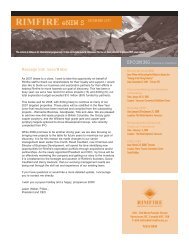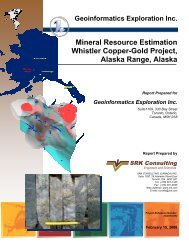view FS - Kiska Metals Corporation
view FS - Kiska Metals Corporation
view FS - Kiska Metals Corporation
You also want an ePaper? Increase the reach of your titles
YUMPU automatically turns print PDFs into web optimized ePapers that Google loves.
<strong>Kiska</strong> <strong>Metals</strong> <strong>Corporation</strong><br />
Notes to the consolidated interim financial statements<br />
March 31, 2012 and 2011<br />
(Expressed in Canadian Dollars)<br />
(Unaudited – Prepared by Management)<br />
21. Income taxes (continued)<br />
At December 31, 2011, the Company has unrecognized losses for income tax purposes of approximately<br />
$68,829,000 which may be used to offset taxable incomes of future years. If unused, these losses will<br />
expire as follows:<br />
2014 $ 955,000<br />
2015 2,632,000<br />
2026 5,330,000<br />
2027 8,247,000<br />
2028 14,786,000<br />
2029 8,163,000<br />
2030 11,026,000<br />
2031 17,690,000<br />
$ 68,829,000<br />
The Company also has unrecognized resource related tax deductions of approximately $8,100,000<br />
available for deduction against future Canadian taxable income, which can be carried forward indefinitely.<br />
In assessing the Company’s ability to utilize deferred tax assets, management considers whether it is<br />
probable that some portion or all of the deferred tax assets will be realized. The ultimate realization of<br />
deferred tax assets is dependent upon the generation of future taxable income during the periods in<br />
which those temporary differences are or become deductible or during the periods before expiry of the<br />
loss carry forwards. Management considers the scheduled reversal of deferred tax liabilities, projected<br />
future taxable income, and tax planning strategies in making this assessment. Based upon the level of<br />
historical taxable income and projections for future taxable income over the periods in which tax assets<br />
are deductible, management currently believes it is probable that the Company will not realize the<br />
benefits of the deferred tax assets.<br />
22. Financial risk management objectives and policies<br />
The Group’s principal financial instruments comprise financial liabilities and financial assets. The Group’s<br />
principal financial liabilities, other than derivatives, comprise accounts payable and accrued liabilities, and<br />
due to related parties. The main purpose of these financial instruments is to manage short term cash flow<br />
and raise finance for the Group’s capital expenditure program. The Group has various financial assets<br />
such as accounts receivable and cash and short-term deposits, which arise directly from its operations.<br />
Risk exposures and responses<br />
The Group manages its exposure to key financial risks in accordance with the Group’s financial risk<br />
management policy. The objective of the policy is to support the delivery of the Group’s financial targets<br />
while protecting future financial security. The main risks that could adversely affect the Group’s financial<br />
assets, liabilities or future cash flows are market risks, comprising commodity price risk, cash flow interest<br />
rate risk and foreign currency risk and liquidity risk and credit risk. Management re<strong>view</strong>s and agrees<br />
policies for managing each of these risks which are summarized below.<br />
The Group’s senior management oversees the management of financial risks. The Group’s senior<br />
management is supported by the board of directors (the “board”) that advises on financial risks and the<br />
appropriate financial risk governance framework for the Group. The board provides assurance to the<br />
Group’s senior management that the Group’s financial risk-taking activities are governed by appropriate<br />
37












